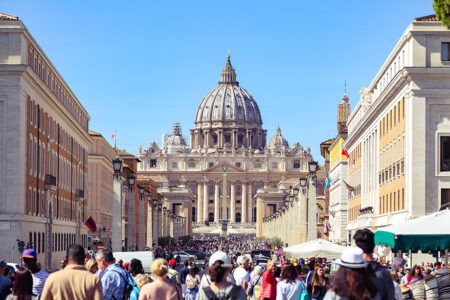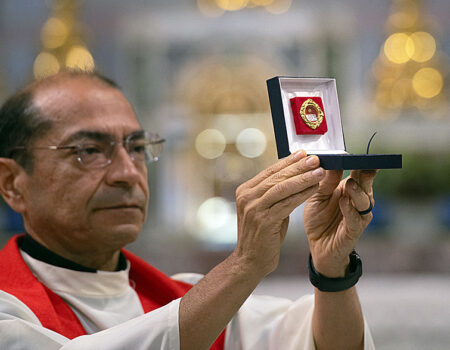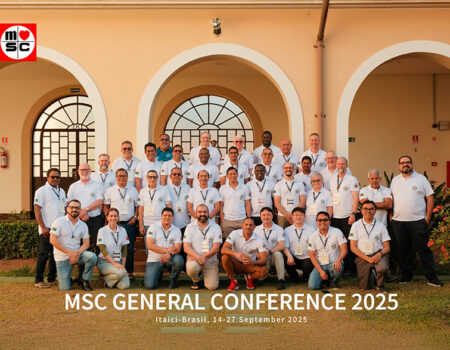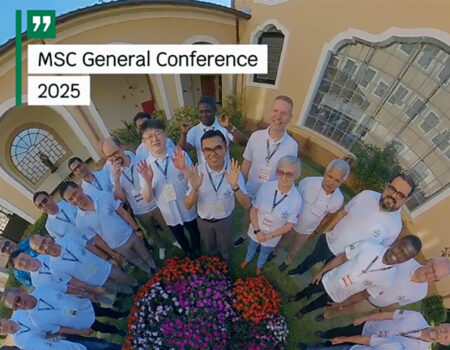Reflection: Jubilee Year
Sunday March 30, 2025

As most know, 2025 is a Jubilee Year in the Catholic Church. For us Christians, we first go to the Israelites in the book of Leviticus, which describes the nature of a Jubilee.
«Seven weeks of years shall you count—seven times seven years—so that the seven cycles amount to forty-nine years. Then, on the tenth day of the seventh month, let the trumpet resound on the Day of Atonement; the trumpet blast shall re-echo throughout your Land. This fiftieth year, you shall make a sacred by proclaiming liberty in the Land for all inhabitants». (Leviticus 25;10)
«The Spirit of the Lord God is upon me . . . to proclaim the year of the Lord’s favour». (Isaiah 61:1-2)
For all Israelites, this Jubilee was a year of total remission. For the Israelites, it was a Holy Year, or Sabbatical year. Freeing Hebrew slaves and giving land back to previous owners were among the actions for the Jubilee Year. The ground also needed to relax. Resting the ground was important. The earth was not to be tilled. Israel was required to provide people experiencing poverty with the produce if anything grew without tilling. Every fifty years, this Jubilee Year takes place. It is unclear whether this was followed exactly as legislated.
In the New Testament, Jesus reads in the synagogue.
«The Spirit of the Lord is upon me because he has anointed me to bring glad tidings to the poor. He has sent me to proclaim liberty to proclaim liberty to captives and recovery of sight to the blind, to let the oppressed go free, and to proclaim a year acceptable to the Lord». (Luke 4:18-19)
Today, it is not until all twelve of Israel’s tribes live together will the next Jubilee be celebrated.
Pope Boniface VIII proposed a Jubilee Year, which followed a similar pattern to Israel’s Jubilee Year. Commencing on February 22, 1300, the commemoration of each fifty-year tradition was followed by this inaugural one. The Church would pardon all of one’s wrongdoings throughout this unique year. For their sins, they would receive full forgiveness. Pilgrims who visited St. Peter’s Basilica would receive numerous indulgences. Daily, at a designated time, residents of Rome were urged to attend the Basilica. Those not living in Rome were invited to come every thirty days. The requisites for visiting St. Peter’s Basilica included sincere sorrow and repentance for all sins, followed by confession before visiting the Basilica of St. Peter. There is no mention of receiving the Eucharist. The papacy of Clement VI added visitations to the papal cathedrals of St. Paul, St. John Lateran, and St. Mary Major.

In 1390, Pope Urban VI proposed a Jubilee year every thirty-three years to imitate Christ’s thirty-three years on earth and because of the short life span on earth. Pope Martin V, in 1450, proposed the celebration fifty days before Easter. Paul II changed it to every twenty years. The Jubilee Year 1825 was the only one celebrated in the 19th century because of politics. Pope Leo XIII opened the Door during a time of political turmoil.
A prominent ritual in the Jubilee celebration is the “opening of the door.” This rite goes back to the 15th century.
· 1900 Jubilee: On December 24, 1899, Pope Leo XIII opened the Holy Door at St. Peter’s Basilica, ushering in a Jubilee year that embraced the tensions and transformations of modernisation. Thousands of pilgrims gathered, witnessing this act of faith.
· 1925 Jubilee: Pope Pius XI began the Holy Year on Christmas Eve, using a ceremonial hammer gifted by bishops worldwide to open the Holy Door, uniting Catholics in prayer and penance.
· 1933 Jubilee of Redemption: Marking 1900 years since Christ’s Passion, Pope Pius XI welcomed over two million pilgrims to Rome in a Jubilee of Redemption, a testament to enduring faith amidst global challenges.
· 1950 Jubilee: Pope Pius XII struck the Holy Door on December 24, 1949, symbolically opening a year of grace for the faithful in the aftermath of World War II.
· 1975 Jubilee: With reconciliation as its central theme, Pope Paul VI crossed the Holy Door’s threshold with invocations to the Holy Spirit, emphasising healing and renewal.
· 1983 Jubilee: Pope John Paul II commemorated Christ’s Passion and Resurrection, opening the Holy Door to invite believers into a transformative state of grace.
· 2000 Great Jubilee: On Christmas Eve 1999, Pope John Paul II opened the Holy Door, celebrating two millennia of Christianity and inspiring hope for a new era.
· 2015 Jubilee of Mercy: In a historic moment, Pope Francis opened the Holy Door in Bangui, Central African Republic, before inaugurating it at St. Peter’s Basilica alongside Pope Emeritus Benedict XVI, emphasising the Church’s mission of mercy.
· 2025 Jubilee of Hope Pope Francis once again opened the Holy Door on Christmas Eve, inviting pilgrims from around the world to reflect on God’s love and salvation in Christ. (1 What Is the Year of Jubilee 2025? (https://www.catholic.com/tract/year-of-jubilee-catholic-answers-guide-to-jubilee-2025)
Today, the Jubilee Year in the Church is celebrated every ten years. In 2025, Pope Francis opened the Jubilee door in St. Peter’s Basilica, Rome, on December 24, 2024. This ritual marked the beginning of the Jubilee Year 2025. It will end on January 26, 2026.

The Jubilee Door, also known as the Door of Mercy, is a striking feature of the opening ceremony. A wonderful symbol with many meanings is the Door. It may represent a time for a shift in behaviour, a conversion, or a rebirth. Christ entering the world through the Door can also be represented by the Door. The Door is also important because it serves as a big announcement of God’s ongoing faithfulness and mercy to His people. The Pilgrim Church is seen as a significant model of the Church. The Church is constantly striving for God’s Kingdom. The Church’s numerous processions serve as a reminder of this admirable model. We can enter the Kingdom of God through the open Door. The liturgy is similar in all four of the great cathedrals in Rome.
The Jubilee Year is a celebration of God’s Mercy. At the same time, it can be a very challenging time for Christians. Interestingly, one of the participatory acts emanating from the Jubilee Year is the “remittance of debts.” Christians committed to Social Justice can pressure countries, business groups, etc. to relieve debts. This writer remembers when, in California, San Bernardino Diocese, the Bishop released the debts burdening the two high schools.
The Jubilee Year is celebrated throughout the Catholic world. It’s a wonderful time to spend time with God and God’s people. Reading papal publications like the 2025 Jubilee’s theme, the Papal Bull on Hope, is beneficial. People go on pilgrimages that allow them to pass through sacred church doors. St. Peter, St. John Lateran, St. Paul Outside the Walls of Rome, and St. Mary Major are Rome’s four main cathedrals.
The prophecy of Micah, “And what does the LORD require of you but to do justice, to love kindness, and to walk humbly with your God?” is recalled during a Jubilee Year. (6:8) It is a time to concentrate on providing food for the hungry, clothing the naked, visiting the ill, and helping the marginalised and voiceless. (Mt. 25) Oppressed people include adults, children, and elderly, who are oppressed. They endure unjust, severe, inconvenient, and unjustifiable oppression. Now is the moment to take action to relieve these folks of their agony. Don’t give up hope during the Jubilee Year. “Hope does not disappoint” (Rom 5:5) is Pope Francis’ proclamation. As the Church is tasked with proclaiming the Lord Jesus as “our hope” (1 Timothy 1:1), may the Jubilee be a time of authentic, intimate experience with the Lord Jesus, the “door” (cf. John 10:7.9) of our salvation. Jubilee Year is a time not to lose hope. For everyone, may the Jubilee be a moment of genuine, personal encounter with the Lord Jesus, the “door” (cf. Jn 10:7.9) of our salvation, whom the Church is charged to proclaim always, everywhere and to all as “our hope” (1 Tim 1:1). (Spes Non Confundit, 1).
Wishing you all a holy lent. Ametur!
Warren Perrotto, MSC
Photos: Centro Televisivo Vaticano. Creative Commons / www.freepik.com





